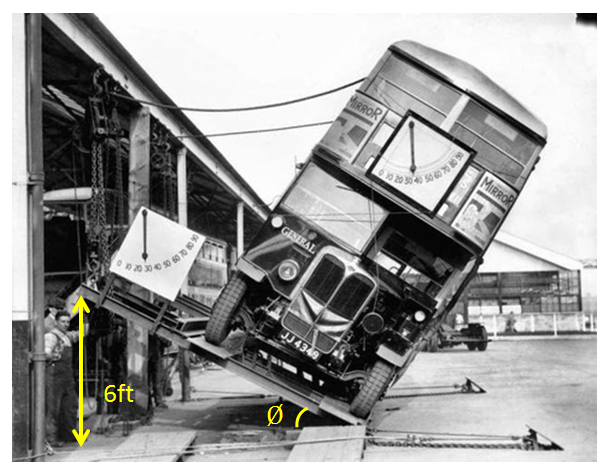The Ultimate Geometry Problem

Look at the image given. It is a real image taken in 1933 - which shows how the makers of the famous London double-Decker buses proved they were not a tipping hazard.
If the person standing is 6ft tall and the bus is almost at its tipping point, by looking at the image and the angles shown in the image, how much can you know about geometry of the surroundings?
For instance (1) what is the value of theta (tipping angle)? (2) Can you find out distance between two mini protractors used for measurement?
What else can you know from the image? For all the required information you can watch this video https://www.youtube.com/watch?v=C-fZA1NJtPA
No vote yet
1 vote
Easy Math Editor
This discussion board is a place to discuss our Daily Challenges and the math and science related to those challenges. Explanations are more than just a solution — they should explain the steps and thinking strategies that you used to obtain the solution. Comments should further the discussion of math and science.
When posting on Brilliant:
*italics*or_italics_**bold**or__bold__paragraph 1
paragraph 2
[example link](https://brilliant.org)> This is a quote# I indented these lines # 4 spaces, and now they show # up as a code block. print "hello world"\(...\)or\[...\]to ensure proper formatting.2 \times 32^{34}a_{i-1}\frac{2}{3}\sqrt{2}\sum_{i=1}^3\sin \theta\boxed{123}Comments
Vikram, besides the fact the bus, being on springs, is tilted over a few more degrees (which explains the difference in protractor readings), I'm not sure what else is being asked for. The distance between the protractors is just over 11 feet, which can be ascertained with a ruler. Also, north must be on the left side, because the shadow is directly underneath the centerline of the bus, and it must be about noon in summer in London, because of the 60 degree angle of the sunlight.
Log in to reply
Hi, Impressive observations as usual. You have even covered things which I had not even considered! :) On a very simple observation, based on the information from video we know that 28 degrees is the Theta and bus is slightly more tilted because of sand bags at 34 degrees. If the side where man is standing is 6ft,, length of the entire rack on which bus is standing is about 12.78ft. and distance from standing man to edge of the rack (touching ground) is about 11.28ft. For me the distance between points of two protractor is about little more than 15.3ft. but I am not too sure so wanted to see if there is some method using which we can find that out analytically? I was wondering if it will help if we knew the height of the bus. You know if am not that good with geometry but I was just curious about the image from the time I saw that Video :)
Log in to reply
I think the reason why we can't determine the distance between the protractors analytically is because we don't know the dimensions of the bus and we don't know how high up on the front of the bus is affixed the 2nd protractor. I think the simplest thing to do is to go get a ruler and measure the elements on the photograph directly, which we can get away with because the relevant elements are roughly all on the same plane parallel to the image plane of the camera. That's how I determined that the center-to-center distance between the protractors is something over 11 feet.
As for the inclination of the sun rays in London, I used an online solar calculator. You really didn't think I'd pull out a boxful of math to compute it in the hard way?
As the bus is empty, most of it's mass is rested below, so the point of gravity is shifted on the lower half of the bus and is inside the stable plane. If the same bus had 5 people on the top floor, the bus probably wouldn't have been so stable.
angle fi is equal to vertical angle made by needle with the left vertical plane.
LAW OF INERTIA!